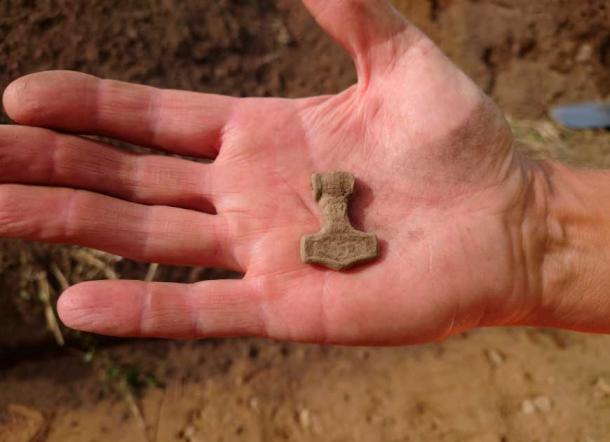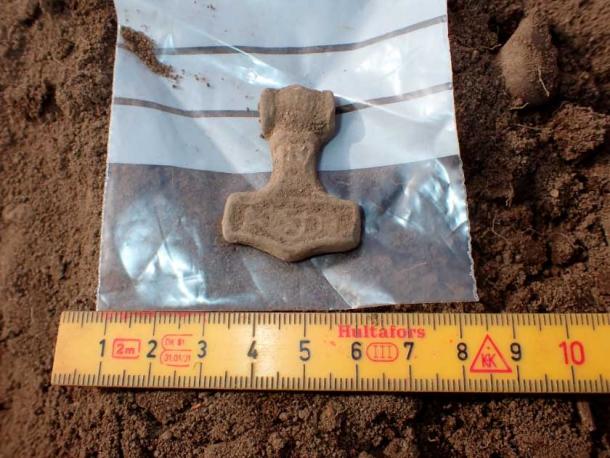Loki’s lies, Odin’s staff and Thor’s hammer (Mjölnir) are well known archetypes of Norse mythology. But now, archaeologists in Sweden have unearthed a real Viking Age Hammer of Thor.
In 2014 pop-culture fans got excited and archaeology looked on in delight as a 10th century Thor’s Hammer amulet was discovered in Torshammere in Købelev, on the Danish island of Lolland. Ancient Origins reported at the time that a set of runes marked on the 1,000-year-old amulet “solved the mystery of why Viking charms were worn for protection.”
Now, another Thor’s hammer protective amulet has been discovered in Ysby, Sweden.
Measuring Up The 10th-Century Viking Treasure
Ysby is a village in Laholm Municipality, Halland County, on the western coast of Götaland, southern Sweden. Ancient Roman silver coins had previously been discovered at the archaeological site, and also at nearby longhouses dating to the early Iron Age. But according to a report on Kulturmiljö Halland this is the first time “a beautiful Hammer of Thor artifact” has been discovered.
Sveriges Radio (Swedish Radio) reported that the delicate hammer-shaped amulet was cast in lead in the late 10th century. It measures about 3 centimeters (1.18 inches) in length. A small hole has been bored into the top of the hammer to hold a yarn, or string. This suggests to the archaeologists that the hammer was worn around the neck as a protective amulet.

Plating Up Viking Amulets
In Norse mythology , Mjönir was Thor’s magical flying weapon that prevented the giants from destroying Asgard, the home of the gods. Therefore, in the Viking Age the symbol was associated with protective powers. While this latest discovery is being called “one of a kind” you should know that hundreds of similar tiny hammer-shaped amulets have been discovered across Scandinavia since the first millennium AD.
Per Wranning from Kulturmiljö Halland says the rare Viking Age artifact is currently being preserved by museologists. After these primary restoration techniques have been carried out scientists will then set about analyzing the object’s metallic composition. Similar artifacts were often silvered or gilded, but only after the restoration is complete will the scientists know if this particular artifact was plated, or not.

A Unique Find, But How So?
This Thor’s Hammer is being called a “one of a kind” because it represents the first such hammer ever discovered in Halland County, which is perhaps best known for the 2014 discovery of a huge Viking drinking Hall. Measuring over 50 meters (164.02 ft) in length and 14 meters (46ft) wide the Drinking Hall was identified near Vadstena in Halland County.
Archaeologists from Stockholm University and Umeå University said “Our investigation demonstrates that non-invasive geophysical measurements can be powerful tools for studying similar building foundations.” While this was a major archaeological discovery dating to the Viking Age, it doesn’t have the finesse that the recently discovered Thor’s hammer holds/offers. Neither do scans of a building’s foundation offer the same deep social/people’s history as the amulet does. So the Thor’s Hammer really is big news for Halland County and its residents.
This Was A Brave Man’s Hammer
Per Wranning said the Thor’s Hammer amulet was worn “during a religious transition period when the area began to be Christianized.” He added that it was most likely “a manifestation and desire to not part with the Asatro, the worship of Norse Gods , when Christianity reached Scandinavia.”
Thus, it can be speculated that about 1,000 years ago a Viking was raging against the machine (Christianity). He perhaps wore this amulet to protect himself, but not from any one the troupe of dark forces available to him from Norse Mythology, rather, from Christians. It should not be forgotten that for Vikings, who worshipped a pantheon of ancient Norse deities, Christians and their relatively new ‘one-god’ were sacrilegious, blasphemous and evil in the face of the old ways of the north.








